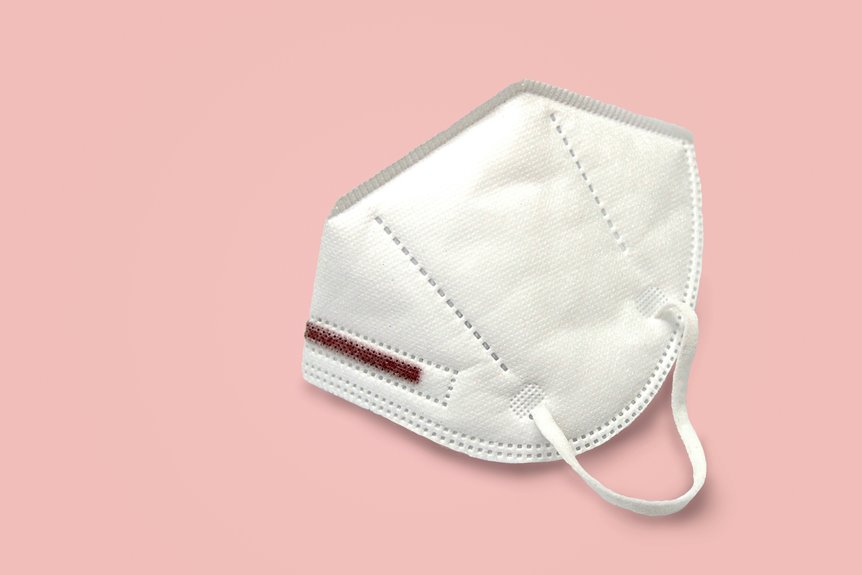If you experience itching, redness, or a rash after wearing polyamide fabric, you might have a sensitivity or allergy caused by the material itself or chemical residues on it. Avoiding polyamide garments and washing new clothes before use can help reduce reactions. You can try a simple skin test at home or consult a doctor for confirmation and treatment options like creams or antihistamines. Keep exploring to discover prevention tips and alternative fabrics that suit sensitive skin.
Table of Contents
Key Takeaways
- Polyamide fabric allergy is caused by sensitivity to chemical residues or treatments on the synthetic fibers.
- Symptoms include itching, redness, rashes, blistering, swelling, and burning where fabric contacts skin.
- Diagnosis involves observing skin reactions, home patch testing, and consulting a dermatologist for professional testing.
- Treatment includes avoiding polyamide, using hydrocortisone creams, antihistamines, and moisturizing affected skin.
- Prevention involves choosing natural fiber alternatives like cotton or bamboo and washing new polyamide clothes before wearing.
What Is Polyamide Fabric?
Polyamide fabric is a type of synthetic textile made from polymers known as polyamides. When you wear polyamide, you’re actually in contact with man-made fibers designed to mimic natural materials like silk or wool.
These fibers are created through a chemical process called polymerization, which links monomers into long chains. You’ll find polyamide in many fabrics because it’s durable, lightweight, and resistant to wrinkles and abrasion.
Polyamide fibers form through polymerization, creating durable, lightweight fabrics that resist wrinkles and wear.
It also has good elasticity, so clothes made from polyamide often fit snugly and maintain their shape. While it’s often blended with other fibers, pure polyamide fabric can feel smooth and slightly shiny.
Understanding what polyamide is helps you recognize why some people might react differently when exposed to this synthetic material.
Common Uses of Polyamide in Clothing
You’ll find this fabric in a wide range of clothing items thanks to its durability and stretch. Polyamide is popular in activewear because it handles sweat and movement well. It’s also common in lingerie for its smooth feel and fit. Outerwear benefits from polyamide’s water resistance, while casual wear uses it for comfort and resilience. When shopping, recognizing polyamide’s presence helps you understand your clothing’s properties.
| Clothing Item | Why Polyamide Is Used |
|---|---|
| Activewear | Stretch, moisture-wicking |
| Lingerie | Softness, elasticity |
| Outerwear | Water resistance, durability |
| Casual wear | Comfort, easy care |
| Swimwear | Chlorine resistance, quick drying |
Causes of Polyamide Fabric Allergy
You might react to polyamide fabric because of leftover chemical residues from manufacturing.
Your skin’s sensitivity also plays a big role in how you respond to these materials.
Plus, treatments applied to the fabric can increase irritation or allergic reactions.
Chemical Residues Impact
Although the fabric itself might be safe for many, chemical residues left from manufacturing can trigger allergic reactions in sensitive individuals.
When polyamide fabrics are produced, chemicals like dyes, finishing agents, and solvents may remain on the material. These residues can irritate your skin, causing redness, itching, or even rashes.
Even if you’ve never reacted to polyamide before, these leftover chemicals might provoke a sensitivity. Washing new polyamide garments thoroughly before wearing can help reduce this risk by removing some residues.
However, if you notice persistent irritation, you should consider the possibility that chemical residues are the culprit. Being aware of this can guide you to choose garments labeled as “low chemical” or “eco-friendly,” which often undergo stricter processing standards to minimize residue presence.
Skin Sensitivity Factors
Because polyamide fabric allergies often result from multiple triggers, understanding your skin’s sensitivity factors is key to managing reactions.
Your skin’s barrier function plays a vital role—if it’s compromised due to dryness, eczema, or irritation, you’re more likely to develop a reaction. Genetics also matter; some people naturally have more reactive skin, making them prone to allergies.
Additionally, frequent sweating or friction where the fabric contacts your skin can increase sensitivity, allowing allergens to penetrate more easily. Environmental factors like heat and humidity can worsen this effect.
Knowing these factors helps you anticipate and minimize contact with polyamide fabrics when your skin is vulnerable, reducing the chance of allergic responses and discomfort.
Fabric Treatment Effects
Understanding your skin’s sensitivity factors sets the stage for recognizing how fabric treatments can trigger polyamide allergies. When polyamide fabrics undergo various chemical processes, these treatments can leave residues that irritate your skin.
You mightn’t realize that dyes, finishes, and softeners add allergens that provoke reactions. Knowing what treatments affect your skin helps you avoid discomfort and allergic responses.
Common fabric treatment effects to watch for include:
- Residual chemical dyes that cause redness and itching
- Formaldehyde-based finishes that trigger contact dermatitis
- Softeners containing fragrance allergens
- Flame retardants that irritate sensitive skin
- Antimicrobial agents linked to allergic reactions
Symptoms of Polyamide Allergy on Skin
If you’re allergic to polyamide fabric, you might notice itching and redness where the material touches your skin.
These common reactions can quickly lead to rashes or even blistering.
Recognizing these symptoms early helps you avoid further irritation and get relief faster.
Common Skin Reactions
When you come into contact with polyamide fabric and experience an allergy, your skin often reacts with redness, itching, and small bumps.
These common skin reactions can vary in intensity, but they usually appear shortly after exposure. You might notice:
- Raised, red patches on the skin
- Small, fluid-filled blisters
- Dry, scaly areas that flake
- Swelling around the affected region
- A burning or stinging sensation
These symptoms typically develop where the fabric touches your skin most, such as the arms, neck, or torso.
If you’ve experienced these reactions, it’s important to recognize them early to avoid worsening irritation.
Identifying and limiting exposure to polyamide fabrics can help prevent these uncomfortable skin responses.
Itching and Redness
Among the various skin reactions caused by polyamide allergy, itching and redness are some of the most noticeable and persistent symptoms.
When your skin comes into contact with polyamide fabric, your immune system may react, triggering intense itching that can be hard to ignore. You’ll often notice redness spreading across the affected area, signaling inflammation.
This discomfort can disrupt your daily routine, making it difficult to focus or relax. The itching usually worsens with continued exposure, so it’s important to identify and avoid polyamide materials as soon as you spot these signs.
Applying soothing moisturizers or antihistamines might help ease the symptoms, but the best approach is to prevent further contact. Recognizing itching and redness early can save you from more severe reactions later on.
Rash and Blistering
Rashes and blistering are common symptoms you might experience with a polyamide allergy. When your skin reacts, you could notice raised, red patches that may turn into painful blisters. These symptoms often appear where the fabric contacts your skin directly.
You might also experience:
- Intense itching around the affected areas
- Swelling or inflammation
- Fluid-filled blisters that can break and ooze
- Dry, cracked skin after blisters heal
- Sensitivity to touch or pressure
If you see these signs, it’s important to stop wearing polyamide fabrics immediately.
Cleanse the area gently and avoid scratching to prevent infection. Seek medical advice if blisters worsen or don’t heal, as you might need treatment to reduce inflammation and discomfort.
How to Diagnose a Polyamide Allergy
Wondering how to tell if you have a polyamide allergy? Start by noting any skin reactions like redness, itching, or blistering that appear after wearing polyamide-containing fabrics.
Keep track of when symptoms occur and which clothes you wore. You can perform a simple patch test at home by placing a small piece of polyamide fabric against your skin for 24-48 hours and watching for irritation.
However, to confirm the allergy, visit a dermatologist who can conduct professional patch testing. This involves applying small amounts of suspected allergens, including polyamide, to your skin under adhesive patches.
The doctor will check for reactions after 48 and 72 hours. Accurate diagnosis helps differentiate polyamide allergy from other skin conditions or fabric sensitivities.
Treatment Options for Polyamide Allergy
If you suspect a polyamide allergy, the best approach is to stop wearing clothes made from this fabric to prevent further irritation.
Beyond avoidance, you can manage symptoms effectively with these treatment options:
- Apply over-the-counter hydrocortisone creams to reduce inflammation and itching.
- Use antihistamines to alleviate allergic reactions.
- Keep the affected skin clean and moisturized to promote healing.
- Take cool baths with colloidal oatmeal to soothe irritation.
- Consult a dermatologist for prescription medications if symptoms persist or worsen.
Act quickly to minimize discomfort and prevent infection.
If you notice severe reactions like swelling or blistering, seek medical attention immediately.
Tips for Avoiding Polyamide in Clothing
Managing symptoms of a polyamide allergy works best when you also limit your exposure to this fabric.
Start by checking clothing labels carefully—polyamide often appears as nylon or elastane blends. Choose garments made from natural fibers or those clearly labeled as polyamide-free.
When shopping online, use filters or search terms to avoid polyamide materials. Wash new clothes before wearing them to reduce residual chemicals that might trigger reactions.
If you’re unsure about a fabric, test it on a small skin area first. Avoid tight-fitting clothes that trap sweat and irritants against your skin.
Finally, communicate your allergy to friends or family who might buy you clothing, ensuring they pick safe options.
These steps can help you minimize contact and keep your skin comfortable.
Alternative Fabrics for Sensitive Skin
Although avoiding polyamide can be challenging, choosing the right alternative fabrics can make a big difference for your sensitive skin.
You want materials that breathe well, feel soft, and reduce irritation. Natural fibers often work best because they’re less likely to cause allergic reactions.
Consider these options:
- Cotton: Soft, breathable, and widely available
- Linen: Lightweight and moisture-wicking
- Bamboo: Hypoallergenic and silky-smooth
- Silk: Gentle on skin but requires special care
- Hemp: Durable and breathable with natural antimicrobial properties
When to See a Dermatologist About Fabric Allergies
Choosing the right fabric can greatly reduce skin irritation, but sometimes symptoms persist despite your best efforts. If you notice redness, itching, or rashes that don’t improve after avoiding polyamide or other suspected fabrics, it’s time to see a dermatologist.
Also, if your skin reactions worsen, spread, or become painful, don’t wait to seek professional advice. A dermatologist can perform patch testing to identify the exact allergen causing your discomfort.
They’ll help you develop a treatment plan, which may include topical medications or lifestyle adjustments. Early consultation prevents complications and helps you manage symptoms effectively.
Frequently Asked Questions
Can Polyamide Fabric Allergies Develop Later in Life?
Yes, you can develop allergies later in life, even to things you tolerated before. Your immune system changes, so reactions to fabrics like polyamide might appear unexpectedly, causing irritation or discomfort where the material contacts your skin.
Is Polyamide Allergy Hereditary?
Think of allergies like unpredictable storms; they don’t always follow family maps. You can develop a polyamide allergy even if no one in your family has it, as it’s usually not hereditary but triggered by exposure.
Do Washing Detergents Affect Polyamide Allergy Symptoms?
Yes, washing detergents can worsen allergy symptoms by leaving irritants on clothes. You should choose hypoallergenic, fragrance-free detergents and rinse thoroughly to reduce skin irritation and keep your skin comfortable when wearing polyamide fabrics.
Can Polyamide Allergy Cause Respiratory Issues?
You might be surprised to learn that yes, polyamide allergy can lead to respiratory issues. If you inhale fibers or dust from the fabric, your airways could react, causing symptoms like coughing, wheezing, or shortness of breath.
Are There Any Natural Remedies for Polyamide Fabric Allergy?
You can try soothing your skin with aloe vera gel or chamomile tea compresses to reduce irritation. Also, wearing breathable cotton clothing helps prevent flare-ups. Always consult a dermatologist before trying new remedies to guarantee safety.
- The Dos and Don’ts of Cleaning Angora Fabric - July 2, 2025
- Is Angora Itchy? 3 Ways to Make Your Garment Softer - July 2, 2025
- Restoring a Matted Angora Sweater: A DIY Guide - July 2, 2025







